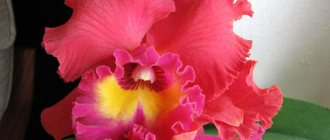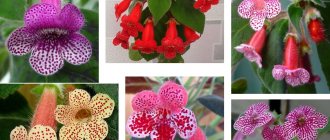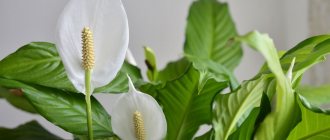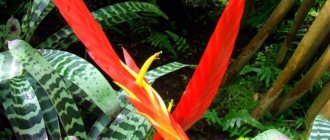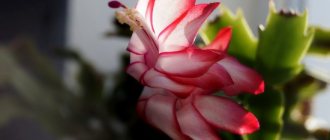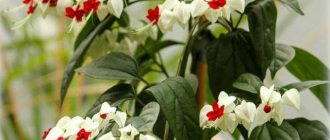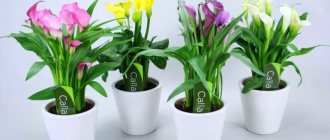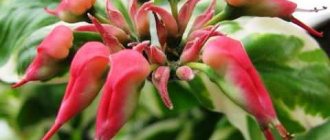When grown indoors, the shrub usually grows no more than 1 meter in height. Its numerous shoots are highly branched and are covered with oppositely located large leathery leaves of a juicy green hue.
The plant can bloom in comfortable conditions all year round. Its inflorescences combine up to 20 medium-sized flowers with smooth or corrugated petals of a snow-white or cream shade; many varieties have a subtle, very pleasant aroma.
See also how to grow indoor plumeria and dipladenia.
| High growth rate. |
| Blooms throughout the year. |
| The plant is easy to grow. |
| Perennial. |
Tabernemontana: care at home. Briefly
| Temperature | In the warm season +22-+25°С, in the cold season – about +15°С. |
| Air humidity | Increased, at temperatures above +20°C, requires additional spraying at least 2-3 times a week. |
| Lighting | Bright, diffused with a moderate amount of direct sun in the morning and shading in the afternoon. |
| Watering | In summer, the flower is watered generously 1-2 times a week, in winter - moderately 1 time a week. |
| Soil for tabernemontana | An industrial substrate with high acidity or a soil mixture of leaf, turf and coniferous soil with the addition of peat and sand (all components in equal parts). |
| Feeding and fertilizer | During the active growing season, apply liquid fertilizer with predominant potassium and phosphorus 2-3 times a month. |
| Transplanting Tabernemontana | As needed: when the old pot becomes small or the soil completely loses its nutritional value. |
| Reproduction | Semi-lignified cuttings and seeds. |
| Features of cultivation | Tabernemontana does not tolerate drafts and temperature changes at home. Healthy plants do not need pruning, but it is useful to periodically pinch the tops for more luxuriant tillering. |
Care
The plant requires bright, diffused lighting, so it should be placed on windowsills facing west, east and southeast.
The temperature suitable for maintaining the shrub should be in the range from 17°C to 22°C. Therefore, in summer it can be taken out onto the street or balcony, and in winter it can be kept in the house away from drafts. The main thing is not to let the room temperature drop below 15°C.
It is advisable to moisten the leaves with settled water. Spraying with a spray bottle has a much better effect on the condition of the bush than watering from a container.
In summer it is worth spraying twice a week, and in winter only once. Fertilizer feeding is needed in spring and summer twice a month.
Caring for Tabernemontana at home. Details
Tabernemontana flowering
A tabernemontana plant at home, with proper care, can bloom continuously throughout the year. Inflorescences appear on the tops of young shoots and consist of 3-20 snow-white or cream flowers with smooth or double petals (depending on the variety). The flowers of most varieties have a pleasant aroma similar to jasmine.
What to do to make tabernemontana bloom in winter
In order to enjoy the lush flowering of tabernemontana in winter, it should be cared for as usual throughout the year. Water the plant abundantly, but moderately, maintain the air temperature in the room at +22°C, and fertilize every 2 weeks.
If necessary, additional illumination of the bushes with artificial light sources will be required.
Temperature
During the period of active growth, domestic tabernemontana feels most comfortable at an air temperature of about +22°C, but in winter the plant needs to be kept in cooler conditions, lowering the temperature to +15°C.
Spraying
High humidity is important for tabernemontana, especially if the air temperature in the room where it grows is above +20°C. The plant favors regular spraying of the foliage with warm, settled water. The procedure is carried out every 2-3 days, taking care to protect the flowers and buds from moisture.
Lighting
The plant needs a lot of light for active growth and abundant flowering, but exposure to direct sunlight on the crown is permissible only in the morning and evening. It is best to place a pot of tabernemontana on an eastern or western windowsill.
A flower placed on a south window should be shaded during hot midday hours.
Watering
In the warm season, water the plant generously 1-2 times a week, but between waterings allow the soil to dry out to about half its depth. Water for irrigation is taken at room temperature, always clean and settled. In winter, the plant is watered less frequently, so that moisture does not stagnate in the soil at the roots.
Pot for tabernemontana
Select a container for the plant that is deep and wide with a drain hole to remove excess moisture. The pot should be such that, if necessary, you can easily shake out the roots of the flower along with the earthen lump. Ball-shaped containers with recesses and recesses on the inner surface are not worth buying for tabernemontana.
Soil for tabernemontana
The substrate for tabernemontana should be breathable and slightly acidified. You can purchase a suitable mixture at a flower shop or prepare it yourself by mixing leaf, turf and coniferous soil with peat and coarse sand in equal proportions.
Feeding and fertilizer
Caring for tabernemontana at home includes regular feeding with liquid phosphorus-potassium fertilizers that do not contain lime. Procedures are carried out 2-3 times a month during the entire active growing season.
Transfer
Tabernemontana has a rather fragile root system, so it does not tolerate any manipulation particularly well.
The plant is replanted as needed, no more than once every 2-3 years, when the pot becomes small or the soil completely loses its nutritional properties. Tabernemontana is transplanted using the transshipment method without destroying the earthen clod.
Pruning tabernemontana
Tabernemontana forms a beautiful crown at home on its own without additional pruning. Only those plants that, as a result of improper care, stretch or twist their shoots, have an untidy shape and grow “crookedly” need to be trimmed.
Rest period
Tabernemontans rest during the winter months, when it is not possible to provide them with adequate conditions for active growth and flowering. During the dormant period, the plant is transferred to a cool room with an air temperature of about +15°C, watering is reduced, and fertilizing is temporarily canceled completely.
General information
Tabernemontana is good at any time of the year.
Its beautiful embossed glossy leaves with veins protruding on the underside and short petioles harmonize perfectly with snow-white flowers, collected three to fifteen pieces in corymbose inflorescences. The charm of the flowers is complemented by a wonderful aroma that intensifies in the evening. It is often confused with the gardenia domestica plant. However, these plants belong to different botanical families and can be distinguished by a simple test: tabernemontana contains milky juice in its shoots and leaves, while gardenia does not. In addition, tabernemontana flowers retain their original color throughout the entire flowering period.
Most often found in indoor culture is tabernemontana terry splayed with amazingly beautiful flowers that reach up to eight centimeters.
Origin of the plant
The name of the flower is very difficult to pronounce, but despite this drawback, flower growers are happy to purchase it. To some it resembles gardenia, to others it resembles jasmine. Tabernemontana reed has no relation to any of these plants. Its name was given in honor of Jacob Theodore Tabernemontanus.
Blooming tabernemontana pleases the eye
The flower is native to Central and South America, where locals call it the “flower of love.” Over time, it began to spread throughout the world. The tree is most often grown indoors. In countries where the air is humid and warm, tabernemontana is an ornamental plant growing in gardens. In America, pest control products are made from parts of the bush, they are added to drinks, and the fruits of certain varieties are eaten.
Tabernemontana and gardenia: differences
Tabernemontana is similar in appearance to the beloved gardenia, so many people easily confuse them.
To prevent this from happening, it is important to know how to distinguish these flowers:
- In poor conditions, the gardenia will hurt, the leaves will turn yellow and fall off. At the same time, tabernemontana will feel great, develop and smell fragrant.
- The flowers of both plants have different shapes and a pleasant aroma; their leaves are significantly different. Gardenia has rounded tips, while tabernemontana has pointed tips.
Types of tabernemontana for indoor conditions
Tabernemontana divaricata
The most common home plant species among gardeners. Its appearance is in the form of a bush, which has many dense branches. The leaves are large and green in color. The plates are glossy. The bush is decorated with white flowers.
Each of them has five petals with small waves along the edges. One inflorescence contains up to twenty flowers. Their scent is similar to that of jasmine. It intensifies in the morning and evening. The fruits have an oblong shape. The flesh is orange inside and green outside.
Crowned
It is a shrub with short height. Its leaves are elongated with a green tint. Small irregularities appear between the veins on the plates. The flowers are white in color and have a yellow center.
They grow in groups of several. Each of them reaches four centimeters. The petals of tabernemontana are double and wavy at the edges. The smell from them is refined and pleasant.
Elegant
The plant produces a weak aroma, but is the most unpretentious when grown at home. The height of the bush is small. The leaves are elongated. The plates are glossy and dense. The flowers can be white or cream in color. Each has five petals.
Holst
It's rare to see this look in anyone's home. Its distinctive feature is the original shape of the flowers. The white petals are unusually curved.
In appearance, the inflorescence resembles a propeller. The oval-shaped leaves have a green tint.
Sanango
Another unusual look. The petals of the flowers took on a bizarre curved shape. The leaves are dense and large in size.
Propagation of Tabernemontana by cuttings
Planting material is cut from semi-lignified shoots of the mother plant. The cuttings should be about 10 cm long and have 2-3 pairs of unfolded leaves. Rooting can be carried out in water or a peat-sand mixture; to speed up the process, the sections are pre-treated with a root formation stimulator.
Roots form slowly, so full rooting can take up to 2 months. If the seedling begins to grow, it can be transplanted into an individual pot; in favorable conditions, it will be able to bloom within a year.
Natural conditions
Crepe Jasmine is commonly grown in gardens for its showy, sweetly fragrant flowers, glossy green foliage and beautiful form which, with its low branching nature, allows it to be grown as a fragrant hedge. It is considered a sacred plant in India and the flowers are offered during ceremonies in Hindu temples.
In the wild, the shrub grows in:
- moderately humid and humid
- subtropical and tropical
- lowland and mid-mountain climates
Typically in frost-free areas with an annual minimum of 16 to 25 °C, an annual maximum of 25 to 37 °C, and annual precipitation of 800 to 2500 mm.
Diseases and pests
Exotic tabernemontana has a rather capricious character. It does not make impossible demands on indoor growing conditions, but it reacts to errors in care with negative changes in appearance.
- Tabernemontana leaves turn yellow (chlorosis) due to unsuitable soil or watering with too cold, hard water. The plant needs to be transplanted into the correct substrate and the watering regime must be adjusted.
- Tabernemontana leaves wilt and turn yellow in soil that is too acidic or when root rot occurs. An urgent inspection of the root system, removing its damaged areas and replanting it in the correct substrate will help save the flower from death.
- Shoots stretch out if the lighting of the plant is poorly organized. In this case, the tabernemontana needs to be moved to a brighter place.
- Tabernemontana buds fall off without blooming if the room is too hot and the air humidity is low. The room should be regularly ventilated (but protect the flower from drafts), and the plant should be sprayed with warm, clean water.
- Tabernemontana leaves fall off during the process of plant renewal. This is a completely natural process, and not a sign of illness or an error in care.
- Tabernemontana leaves split when not watered enough or lack nutrients. The plant needs to organize an optimal regime of watering and fertilizing.
- White droplets appear on the underside of the leaves when there is excessive soil moisture or after a sharp temperature change. It is also possible that these are traces of flower parasites. The flower is examined, treated with an insecticide if necessary, and comfortable conditions for growth are provided.
- The flower grows poorly, the leaves turn yellow, buds do not form - most likely the roots are cramped in the pot and need to be transplanted into a larger container.
- The edges of the leaves darken and dry out when there is low humidity and irregular watering. Regulating these components of care helps solve the problem.
- Dark spots on the petals may be the result of overwatering. The soil in the pot should be slightly dried between waterings.
- Holes in the leaves appear due to irregular watering. Even short-term drying of the soil should not be allowed, as this will quickly cause the plant to lose its decorative properties.
Scale insects, aphids, mealybugs and spider mites are dangerous for tabernemontana. When they appear, the plants are immediately treated with special insecticidal preparations.
Possible problems
Tabernemontana, growing at home, has a picky nature. It grows quite well indoors, but if it is not properly cared for, this will certainly affect its appearance. The gardener may have problems with the plant such as:
- Chlorosis, with yellowing of the foliage . It develops due to poor-quality soil mixture or as a result of watering with very cold water of high hardness. Replant the bush in a suitable soil mixture and adjust the watering.
- The foliage turns yellow and dries out . With the development of root rot or in an overly acidic substrate. Inspect the root system and cut out any damaged parts. Plant the shrub in a suitable soil mixture.
- Pulling out the stems . Poor lighting.
- Flying around unopened buds . The room temperature is extremely high and the humidity is low. Provide systematic ventilation, while protecting the bush from drafts. Also, do not forget to moisten it regularly with a sprayer.
- Flying leaves . This process is natural; this is how foliage rejuvenates.
- Delamination of sheet plates . The plant feels an acute lack of nutrients or lack of moisture in the soil.
- Formation of white drops on the underside of foliage . Due to a sharp change in temperature or due to stagnation of moisture in the substrate. This could also be a sign of the presence of a pest. Inspect the plant and treat it with an insecticidal preparation. Provide it with optimal conditions for growth.
- Slow growth of the bush, yellowing of the foliage, failure to bloom . The root system is very cramped in the old container, so an urgent transplant into a larger pot is required.
- Drying and darkening of the edges of leaf plates . The air in the room is too dry and the watering regime is incorrect.
- There are dark spots on the surface of the petals . As a result of waterlogging of the substrate.
- Holes appear on the foliage . The plant is watered irregularly. Make sure that the earthen ball in the pot does not dry out completely, as this will negatively affect the appearance of the plant.
- Pests . Most often, aphids, spider mites, scale insects and mealybugs settle on the bush. To get rid of them, use a suitable insecticide.
Types of Tabernemontana domestica with photos and names
Tabernemontana divaricata (lat. Tabernaemontana divaricata)
The most popular variety in indoor floriculture with densely branching shoots and large leathery leaves of a dark green hue. The inflorescences are very lush, combining up to 20 pieces. snow-white flowers with ruffled petals and a delicate jasmine aroma.
Elegant Tabernaemontana or elegans (Tabernaemontana elegans)
An unpretentious variety with narrow elongated leaves of a juicy green hue. The flowers are large, non-double, white or cream-colored, collected in umbellate inflorescences of 3-10 pieces. Their aroma is very weak, unlike other varieties.
Tabernemontana crowned (lat. Tabernaemontana coronaria)
Compact, highly branched shrub with raised, oval-shaped leaves of a dark green hue. Umbrella inflorescences appear on the tops of shoots and unite up to 15 medium-sized flowers with single petals of pure white color with a pronounced aroma.
Tabernemontana Holst (lat. Tabernaemontana holstii)
A rare variety with elongated oval-shaped leaves of a juicy green color. The flowers are snow-white, quite large, with an unusual shape of petals - long and curved, similar to propeller blades.
Tabernaemontana sananho (lat. Tabernaemontana sananho)
A spectacular plant with large, very dense leaves of a rich green hue and unusual flowers, the thin snow-white petals of which are intricately twisted along the entire length.
Botanical description
The tabernemontana plant is a branching bush or tree up to one and a half meters high with woody shoots. Pointed at the ends, oblong leathery glossy bright green leaves up to 20 cm long and up to 5 cm wide are located oppositely on the shoots. Because of the leaves, tabernemontana, on which the flowers have not yet opened, is often confused with gardenia, but once the fragrant cream or white double flowers, reaching a diameter of 5 cm, bloom, the difference becomes obvious: tabernemontana flowers look like bells with corrugated petals, and form complex corymbose inflorescences. The fruit of tabernemontana is a large leaflet in which numerous seeds ripen.
Curious notes about the tabernemontana flower
If you are not sure which representative of the flora is in front of you - gardenia or tabernemontana, then, despite their external similarity (they belong to different families), the differences are in the outlines of the flowers. In the first plant they resemble a rose (some people think of its appearance as decorations on a cake), the same strong, oily-looking petals with a smooth surface and the same milky or creamy tint of the flower. When the buds of tabernemontana bloom, a bell-shaped corolla is immediately noticeable, and the surface of its petals has a corrugated structure. Gardenia flowers mostly grow solitary, and only occasionally gathering a couple of buds together, the second representative of the green world pleases with corymbose inflorescences, in which the number of buds varies from three to 15 pieces. The color of the flowers does not change over the entire period, and gardenia at first pleases with snow-white or cream tones of flowers, but over time they become yellow.
Propagation of Sansevieria by leaf
Beginning flower growers should know how Sansevieria reproduces. Sansevieria flowers can be propagated by leaves. As in other cases, preparation begins with choosing the soil.
What soil is suitable for sansevieria
How to prepare soil for sansevieria at home was described above. But what if you plan to grow these plants outside and is this possible? In fact, if the ambient temperature allows you to plant a flower outside, this will only benefit Sansevieria. It will begin to grow better, and the leaves will become stronger and more beautiful. What should be the soil for sansevieria?
To make the plant feel most comfortable, it is recommended to choose leaf or turf soil for its cultivation, to which sand and humus are added in small proportions.
Note! Sansevieria does not tolerate acidic soil. In this case, the flower will grow very slowly, and the leaves will become covered with unhealthy spots.
Choosing a pot
If Sansevieria is to be grown indoors, you need to pay special attention to choosing a suitable pot. Since this flower grows quickly, it requires a fairly wide container so that the roots are not damaged due to being too close to each other.
As soon as it becomes noticeable that the pot you are using has become too small, it needs to be replaced with a larger one, but not too deep.
The material of the pot should be strong and its walls thick. This requirement should be observed so that the vessel does not burst under the pressure of actively growing roots.
Sansevieria in a pot
Technique for propagating Sansevieria by leaf
This plant can be propagated at any time of the year; it will take root in any case. However, the most favorable period is undoubtedly spring, when all vital processes in the flower are activated.
For Sansevieria flowers, leaf propagation is one of the most common methods. A favorable outcome of reproduction depends on whether the leaf was chosen correctly. So, for this procedure it is worth choosing a healthy leaf from a rosette in which new leaves are no longer observed. The sheet needs to be cut into several fragments, each about 10 centimeters in size.
Note! When cutting a sheet, you need to remember where the top and bottom of the sheet are. Place a piece of leaf in water or soil only with the bottom part, otherwise the cutting will not give roots
After cutting, you can do one of two things: place the sheet either in water or in soil.
The propagation technique using a container of water is carried out step by step as follows:
- Prepare the necessary tools and a container of water, cut off a sansevieria leaf.
- Cut the sheet into pieces, marking the bottom.
- Place the resulting pieces in water.
- When the flower has roots, you can begin to root it in a pot with soil.
To plant leaves in the ground, you need to do the following:
- Prepare pieces of leaf and a small container with soil.
- Dry the resulting leaf fragments a little by placing them in a dry place for several hours.
- Place the leaf fragments in the ground with the bottom part and gently sprinkle them.
- After about 2 months, transplant the already rooted plant into a permanent container with soil.
How to transplant a pike tail depends only on the wishes of the grower, since both methods are effective.
Leaves for propagation
How to remove a growing point from Sansevieria
If a plant has reached a certain size and is supposed to stop there, many people think about how to remove the growing point.
First you need to find out where it is located. The growing point is the place from which new leaves emerge. In Sansevieria it is located in the center of the leaf rosette, between the upper leaves. By pinching this place with your hand or carefully cutting it off, you will be able to get rid of the appearance of new leaves and the growth of the bush.
What is a plant
Tabernemontana is a plant native to Central and South America.
The flowers are white and beige, they are double and pleasant to the touch. There are quite a lot of types.
Tabernemontana is a very unpretentious, evergreen indoor plant, so it quickly finds owners.
An interesting feature of the flower is that the aroma increases with the onset of dusk and darkness.
Home care
1. The temperature in the room where Tabernemontana grows should be moderate. The plant should not be overcooled, as this may affect flowering.
2
The plant requires good lighting, which is very important to consider. On hot summer days, you need to shade the plant so that the sun does not burn the leaves.
3. Tabernemontana needs to be watered moderately, avoiding even short-term drought in the soil. When it dries about halfway, then you need to water it again.
Water for irrigation must either be filtered or allowed to sit for a day. It should also be cool, but not cold. In summer, the plant needs to be watered more often, in winter, much less often.
4
Air humidity should be increased, which is very important. You also need to give the plant a warm shower, or wipe the leaves with a damp sponge.
If the air in the room is too dry, then the plant must be sprayed, but only with settled water. The water should be allowed to sit for a day.
5. The plant needs to be pruned to give it a beautiful shape.
6. Tabernemontana needs to be fed with complex fertilizers, approximately once every two weeks. This will be enough and she will grow well.
7. Various pests can settle on the plant: aphids, scale insects, whiteflies and others. Onion or garlic decoctions will save the plant from them.
8. If the leaves are yellow and limp, then the reason is a lack of watering.
If the color of the plant begins to fade, the reason is not enough light.
If buds that have not yet bloomed begin to fall off, the reason is too high a temperature or low air humidity.
If the leaves fall, do not worry, as the plant gets rid of the old ones. On the back of the leaves you can see small white drops, which then begin to turn yellow.
This process is not related to diseases, so there is no need to worry. This is the release of a substance from the leaves that appears as a result of heavy watering and a sharp change in air temperature. At the same time, this process does not harm the plant at all.
Signs and superstitions
1. Positive action.
If a plant grows in the house of an unmarried girl, then most likely she will find love. If in the house of a married woman, then it will protect her from adultery.
The plant absorbs negative energy, giving out positive energy. It charges people with positivity and can bring harmony and mutual understanding to the family.
2. Negative action.
The plant can bring trouble to the family. It can also cause a rift between loved ones and destroy a family. The owners of the house may be haunted by failures in their personal lives or financial well-being.
Tabernemontana will decorate your home and become an exclusive element of interior decor.
Growing problems and diseases
If the plant's foliage turns yellow, this is a consequence of chlorosis. To avoid the development of this pathology, when replanting you need to use only slightly acidic soil. In addition, the culture must be regularly treated with a solution of microelements.
If holes appear on the tabernemontanthus, this may be the result of uneven or excessive watering. To prevent this, excessive soil moisture should be avoided.
Sometimes whitish pimples appear on the foliage of the plant. Some gardeners believe that this is a symptom of a disorder. In the stem and leaves of the plant there are tubules with milky juice, which sometimes comes out and hardens, so white spots and pimples on the plant are normal.
Main types
Tabernaemontana divaricata
This evergreen, highly branched plant is represented by trees and shrubs. There are large dark green, shiny leaves that are located opposite. They can reach from 15 to 20 centimeters in length and have an oblong shape with pointed tips. On the underside of the leaf blade, transverse veins are clearly visible. The location of the branches is almost horizontal. Double or simple flowers, painted white, have a five-petal corolla, with the petals slightly curved in a spiral. The smell is quite persistent and similar to the aroma of jasmine. At the same time, the aroma becomes stronger at night. The fruit has a pod-like shape. Its outer part can be wrinkled or smooth and dark green in color, sometimes light dots can be seen on the surface. The juicy pulp is orange in color.
Tabernaemontana elegans
This compact evergreen tree is highly branched. Outwardly, it is similar to Tabernemontana divaricata, but it is slightly smaller in size. Its flowers are not so fragrant, but this species is distinguished by its unpretentiousness and resistance to frost and direct rays of the sun.
Tabernaemontana coronaria
This evergreen tree is highly branched. Glossy oval leaves with pointed tips are colored rich green. Their length can vary from 6 to 12 centimeters, and width - from 5 to 8 centimeters. The leaf blade is convex between the veins, which are clearly visible on the underside, which has a lighter color. The formation of flower buds occurs at the tops of the stems. At the same time, 2 lateral growth buds wake up. By the beginning of the flowering period, 2 small leaves appear from such buds. And when flowering ends, the stems begin to grow intensively. After 2, 3 or 4 internodes, flower buds are formed again and the branches bifurcate. The inflorescence bears 3–15 buds, which open gradually. Small (diameter 3–5 centimeters) semi-double flowers have delicate petals that are corrugated along the edge. They are distinguished by an exquisite and delicate smell, while it is strongest in recently opened flowers.
